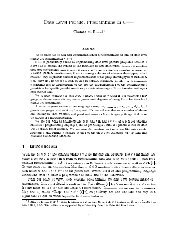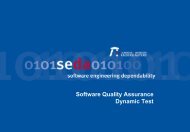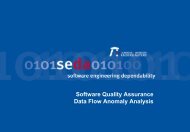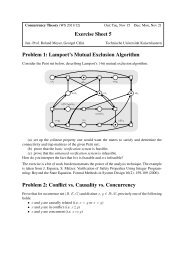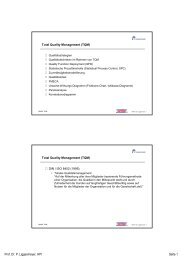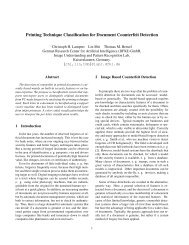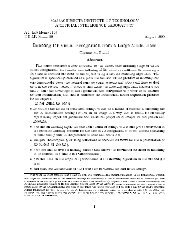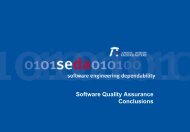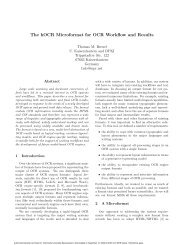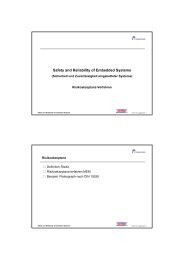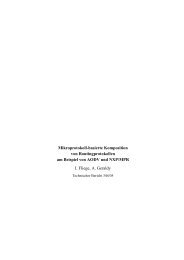FMECA
FMECA
FMECA
You also want an ePaper? Increase the reach of your titles
YUMPU automatically turns print PDFs into web optimized ePapers that Google loves.
Safety and Reliability of Embedded Systems<br />
(Sicherheit und Zuverlässigkeit eingebetteter Systeme)<br />
<strong>FMECA</strong> (Failure Modes, Effects and Criticality Analysis)
Safety and Reliability of Embedded Systems<br />
© Prof. Dr. Liggesmeyer<br />
Content<br />
• Definition<br />
• Accomplishment<br />
• Literature<br />
2
<strong>FMECA</strong><br />
Definition<br />
• Failure Modes, Effects and Criticality Analysis (<strong>FMECA</strong>) is a preventive<br />
method for the identification of problems, their risks and effects (DIN 25448, IEC<br />
812)<br />
• <strong>FMECA</strong> has the following goals:<br />
• Detection of hazards and problems<br />
• Identification of potential risks<br />
• Quantification of risks<br />
• Determination of corrective measures<br />
• <strong>FMECA</strong> can be performed as component <strong>FMECA</strong> (e.g. for a hardware module),<br />
as system <strong>FMECA</strong> (e.g. for a medical device) or as process <strong>FMECA</strong> (e.g. for a<br />
system development process)<br />
3<br />
Safety and Reliability of Embedded Systems<br />
© Prof. Dr. Liggesmeyer
<strong>FMECA</strong><br />
Accomplishment<br />
• <strong>FMECA</strong> is done in the following steps<br />
• Fault analysis: Collection of possible faults including available information about the type, causes and<br />
consequences<br />
• Risk evaluation with the aid of the risk priority number (RPN)<br />
RPN = occurrence probability * severity of consequences * probability of non-detection<br />
• If for the three influencing factors a value between 1 and 10 is used (1= no risk, minor<br />
occurrence; 10 = high risk, high occurrence), the RPN is a value between 1 and 1000<br />
• The risk priority number generates a ranking for the causes of faults<br />
• Causes of faults with a high risk priority number are to be handled with priority<br />
4<br />
Safety and Reliability of Embedded Systems<br />
© Prof. Dr. Liggesmeyer
<strong>FMECA</strong><br />
Accomplishment<br />
• Formulate proposed actions<br />
• Gear proposed solutions towards fault prevention<br />
• High occurrence probabilities of faults: An improvement is definitely necessary (also in the case<br />
of low severity and high detection probability)<br />
• High severity: In this case corrective measures are also required because of the consequences<br />
• High non-detection probability: Improvement of detection probability by suitable analytical<br />
instruments<br />
• Decide for actions<br />
• Analyze residual risk (recalculate RPN)<br />
• Conduct cost-benefit analysis<br />
• Comparison of RPN before and after the improvement<br />
• Relate obtained improvement to invested effort<br />
5<br />
Safety and Reliability of Embedded Systems<br />
© Prof. Dr. Liggesmeyer
<strong>FMECA</strong><br />
Accomplishment<br />
Safety and Reliability of Embedded Systems<br />
© Prof. Dr. Liggesmeyer<br />
Evaluation<br />
Severity (S)<br />
Probability of Occurrence (O)<br />
Probability of Non-Detection (D)<br />
Description<br />
Description<br />
Description<br />
Probability<br />
10 Hazard, violation of laws Failures almost certain; Numerous faults are known<br />
with the same or similar constructions<br />
No detection procedures<br />
known or planned<br />
< 90%<br />
9 Hazard, violation of laws possible Very large number of failures is likely Detection possible but<br />
uncertain<br />
90%<br />
8 Total loss of function, customer very angry Large number of failures is likely Very low probability<br />
7 Functions severely limited, customer angry Moderately large number of failures is likely Low probability of<br />
detection<br />
98%<br />
6 Failure of individual main functions,<br />
customer quite angry<br />
Moderate number of failures is likely<br />
Almost moderate<br />
probability of detection<br />
5 Moderate usage restriction, customer a bit<br />
angry<br />
Occasional failures are likely<br />
Moderate probability of<br />
detection<br />
4 Slight usage restriction, customer<br />
displeased<br />
Probably few failures<br />
Moderately high<br />
probability of detection<br />
99.7%<br />
3 Minor usage restriction, customer slightly<br />
displeased<br />
Probably very few failures<br />
High probability of<br />
detection<br />
2 Very low impact, customer barely affected Failures rare Very high probability of<br />
detection<br />
99,9%<br />
1 Customer does not notice impact Failures unlikely, similar constructions without<br />
failures so far<br />
Almost certain detection 99.99%<br />
6
Safety and Reliability of Embedded Systems<br />
© Prof. Dr. Liggesmeyer<br />
<strong>FMECA</strong><br />
Accomplishment<br />
<strong>FMECA</strong> Worksheet<br />
Title: Coiling process <strong>FMECA</strong> Date: 01 Sep. 2009<br />
System/process/subsystem/component: Coiling process Page: 1/5<br />
Analyst: John Doe<br />
Proved by: Jane Doe<br />
Ref. No<br />
Process/<br />
Component<br />
/Function<br />
Failure Mode Effect of Failure Cause of Failure Current Countermea<br />
sures<br />
Prevention<br />
/testing<br />
methods<br />
Responsibility<br />
Appointment<br />
O S D RPN Performed<br />
measures<br />
Improved (new)<br />
O S D RPN<br />
1 Coiling (coil<br />
uniformly<br />
according to<br />
Example directive 014.325 )<br />
Influences<br />
Where<br />
could there<br />
be some<br />
problems<br />
Number of<br />
turns in the<br />
coil is too<br />
high<br />
How would<br />
the failure<br />
manifest<br />
itself<br />
Resistance of the<br />
wire is too high<br />
• Relay does not<br />
activate<br />
• Malfunction<br />
What could<br />
happen in<br />
case of<br />
failure<br />
Interruption of<br />
the counter for<br />
the number of<br />
turns in the coil<br />
Why would<br />
the<br />
failure/effect<br />
be caused<br />
Calibrate<br />
counter<br />
periodically<br />
6 8 8 384 Clean the<br />
gear<br />
transmission<br />
Which<br />
measures are<br />
planned in<br />
terms of serial<br />
production<br />
With which<br />
risk RPN<br />
unit of the<br />
counter<br />
(3*8*8=192)<br />
Production<br />
technician<br />
30 Sep.09<br />
What should<br />
who carry out<br />
till when<br />
New<br />
counter +<br />
control<br />
01.Oct.09<br />
2 8 4 64<br />
What<br />
measures<br />
have been<br />
implemented<br />
and when<br />
With which<br />
risk RPN<br />
p<br />
T<br />
Structure Failure Description Evaluation Recommendation Re-Evaluation<br />
Improvement Control<br />
7
<strong>FMECA</strong><br />
Literature<br />
Safety and Reliability of Embedded Systems<br />
© Prof. Dr. Liggesmeyer<br />
• DIN 25448, Ausfalleffektanalyse (Fehler-Möglichkeits- und -Einfluß-Analyse),<br />
Berlin: Beuth Verlag, Mai 1990<br />
• IEC 812, Analysis Techniques for System Reliability - Procedure for Failure<br />
Mode and Effect Analysis (FMEA), International Electrotechnical Commission,<br />
1985<br />
• Liggesmeyer, Qualitätssicherung softwareintensiver technischer Systeme,<br />
Heidelberg: Spektrum-Verlag, 2000<br />
• Mäckel O., Software-FMEA: Chancen und Nutzen der FMEA im<br />
Entwicklungsprozess, QZ Qualität und Zuverlässigkeit, Januar 2001, pp. 65 – 68<br />
8




